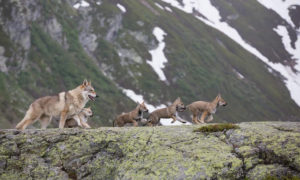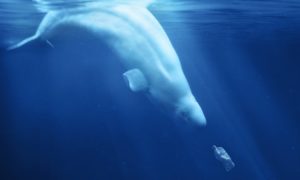Event Cinema
Wednesdays for the Planet | Corona: The Pandemic and the Pangolin

Wednesdays for the Planet is a series of online screenings and virtual presentations with experts highlighting the natural world and other environmental challenges our planet faces. The virtual screenings are for educational purposes, non-profit and non-commercial.
World Wildlife Day
For the month of February, we will be showcasing nature documentaries leading up to World Wildlife Day on 3 March, the day of signature of the Convention on International Trade in Endangered Species of Wild Fauna and Flora (CITES) in 1973.
The Earth is home to countless species of fauna and flora – too many to even attempt counting. This rich diversity, and the billions of years during which its myriad elements have interacted, are precisely what has made our planet inhabitable for all living creatures, including humans. Historically, we have depended on the constant interplay and interlinkages between all elements of the biosphere for all our needs: the air we breathe, the food we eat, the energy we use, and the materials we need for all purposes. However, unsustainable human activities and overexploitation of the species and natural resources that make up the habitats and ecosystems of all wildlife are imperiling the world’s biodiversity. Nearly a quarter of all species are presently at risk of going extinct in the coming decades, and their demise would only speed up the disappearance of countless others, putting us in danger as well.
On World Wildlife Day, we celebrate the special place of wild plants and animals in their many varied and beautiful forms as a component of the world’s biological diversity. We will work to raise awareness of the multitude of benefits of wildlife to people, particularly to those communities who live in closest proximity to it, and we will discuss the threats they are facing and the urgent need for governments, civil society, private sector actors and individuals to add their voices and take actions to help conserve wildlife and ensure its continued use is sustainable.
Documentary
Corona: The Pandemic and the Pangolin
At a time when we are bombarded with COVID-19 information comes a moment of clarity – and a warning we cannot afford to ignore.
Connect via Skype with conservation icon Jane Goodall, controversial marine activist Paul Watson and a cast of experts quarantined in home offices and living rooms around the world, to hear their perspectives on our worst nightmare come true.
Revealing dialogues and relevant stories combine with raw, up to date images and Terra Mater’s classic, inspiring blue-chip footage, in a film to make you pause, feel and act.
As accusations and blame are cast on the failures of governments; as talk of coverups and conspiracies multiply; we invite audiences to change focus. In this film we ask – who is really behind the pandemic?
This is not just a story about today. There is nothing new about viruses that jump from animals to humans causing life threatening diseases.
David Quammen, author of a book written in 2012 that warns about the next human pandemic, reminds us of deadly viruses like Ebola, MERS, Hendra, and West Nile. The drumbeat continues with SARS-COV 2. The difference is, this one is affecting the world. According to Paul Watson, “this one is affecting white people.”
Our guests hold no punches.
Scientists with hands on experience of emerging zoonotic diseases like Tracey McNamara, who found West Nile Virus in New York in 1999, see lessons for today. For decades she and other experts have called on governments to connect human, animal and environmental health. Spend more money on surveillance Tracey urges, or we will not detect the next viral threat “until we have a lot of people in an emergency room – or bodies in the morgue.”
Why the title? Who knew what a pangolin was before this pandemic – before reports that it may or may not carry SARS COV 2? Chinese activist Jinfeng Zhou shows exclusive footage of pangolins suffering from suspected coronaviruses months before the outbreak. But, he says, even if the pangolin is not the source of this SARS coronavirus, it has become the symbol of this pandemic.
And the pangolin has become the symbol of our film – a symbol of the illegal and brutal wildlife trade run by organized criminals. Wildlife crime investigator Andrea Crosta takes us to where it begins.
In the jungles of Gabon, in a poacher’s camp, torch light illuminates the carcasses of slaughtered animals packed on top of one another, bodily fluids mixing. Here is a potential for deadly viruses to jump species. Andrea likens it to a Pandora’s box. We have opened that box.
“We have offered viruses a golden opportunity for evolutionary success.”– David Quammen
Online Screening
The Geneva Environment Network would like to thank Jackson Wild, Off the Fence and Terra Mater Factual Studios for the documentary and the virtual panel discussion.
Watch the trailer; the full film is available until 3 March 2021.
Experts
Panel:
- Dr. Tracey McNamara, professor of Pathology at Western University of Health Sciences College of Veterinary Medicine
- David Quamenn, writer and author
- Susanne Lummer, producer of Corona: The Pandemic and the Pangolin
- Ruth Berry, writer of Corona: The Pandemic and the Pangolin
- Walter Köhler, founder and CEO of Terra Mater Factual Studios
- Moderator: Jeff Flocken, President of Humane Society International
Links
- COVID-19 and the environment| Geneva Environment Network
- Africa’s year of zero: a special report on the future of wildlife tourism | Sophy Roberts | Financial Times | 28 October 2020
- Coronavirus: Half a million sharks ‘could be killed for vaccine’, experts warn | Aisha Zahid | Sky News | 28 September 2020
- It is Time for a Global Wildlife Health Authority | William Karesh, Richard Kock, Catherine Machalaba | IUCN | 17 September 2020
- COVID-19 and adaptive leadership | IUCN | 31 August 2020
- Six million Euros made available for conservation action to counter COVID-19 impacts | IUCN | 3 August 2020
- Extinct-in-the-wild species’ last stand | Amanda Trask, Stefano Canessa, Axel Moehrenschlager, Scott Newland, Suzanne Medina, John Ewen | Science | 31 Jul 2020
- Will Covid-19 tame China’s wildlife trade? | Christian Shepherd and Qianer Liu | Financial Time | 30 July 2020
- Coronavirus: New wildlife trade regime needed to avoid next pandemic | FT Interview | 9 July 2020
- Nature In All Goals 2020 | WWF | 8 July 2020
- Coronavirus lockdowns increase poaching in Asia, Africa | Aniruddha Ghosal and Michael Casey | AP | 22 June 2020
- The invisible trade: Wild plants and you in the time of COVID-19 | TRAFFIC | 18 June 2020
- “We are very worried about Covid-19 spreading to great apes” – IUCN Geneva | Kyra Dupont | Geneva Solutions | 2 June 2020
- #CovidCrimeWatch – n°10 | WILDLIFE CRIME: RISE OR FALL? | The Global Initiative | 27 May 2020
- What COVID-19 means for ecotourism | UNEP | 26 May 2020
- Conserving nature in a time of crisis: Protected areas and COVID-19 | IUCN | 25 May 2020
- The wild animals at risk in lockdown | Alexander Matthews | BBC | 21 May 2020
- Conservation must not be a COVID victim | John Scanlon | The Independent | 13 May 2020
- There are no winners in the illegal trade in wildlife | Ivonne Higuero (CITES SG) | UNEP | 5 May 2020
- As wildlife tourism grounds to a halt, who will pay for the conservation of nature? | Johan Robinson | Mongabay Conservation News | 23 April 2020
- Quarantining also means caring for our great ape relatives | Elizabeth L. Bennett (Vice President for Species Conservation at the Wildlife Conservation Society – WCS) | IUCN Crossroafds Blog | 15 April 2020
- Nature’s comeback? No, the coronavirus pandemic threatens the world’s wildlife | Charlie Gardner (University of Kent) | The Converstation | 8 April 2020
- Poaching threats loom as wildlife safaris put on hold due to COVID-19 | Dina Fine Maron | National Geographic | 10 April 2020
- COVID-19—the role of wild plants in health treatment and why sustainability of their trade matters | Anastasiya Timoshyna, Ling Xu, Zhang Ke | TRAFFIC | 7 April 2020
- 3 ways the coronavirus is affecting animals around the world | Josephine Moulds | World Economic Forum | 7 April 2020
- Tiger tests positive for coronavirus at Bronx Zoo, first known case in the world | Natasha Daly | National Geographic | 5 April 2020
- The coronavirus lockdown as a threat for many animals, not a blessing |Matt Simon | WIRED | 4 April 2020
- Great apes and covid-19, an additional threat to already endangered species? | UNESCO | 1 April 2020
- How zoos must change to keep great apes safe from coronavirus| Lesley Elizabeth Craig | The Conversation | 1 April 2020
- COVID-19-led ban on wild meat could take protein off the table for millions of forest dwellers | Robert Nasi and John E. Fa | CIFOR Forest news | 30 March 2020
- Wildlife rescue centres struggle to treat endangered species in coronavirus outbreak | Gloria Dickie | The Guardian | 28 March 2020
- Les humains sont confinés, la nature reprend ses droits | AFP | 28 March 2020
- Virus which causes COVID-19 threatens great ape conservation | UNEP | 25 March 2020
- Coronavirus poses lethal threat to great apes, experts warn | Damian Carrington | The Guardian | 24 March 2020
- COVID-19: protect great apes during human pandemics | Thomas R. Gillespie & Fabian H. Leendertz | Nature | 24 March 2020
- Great apes, COVID-19 and the SARS CoV-2 | UCN SSC Wildlife Health Specialist Group and the Primate Specialist Group,Section on Great Apes | 15 March 2020
More Documentaries for #WorldWildlifeDay

The Sanctuary: Survival Stories of the Alps
An incredible journey through the frozen heart of Europe to discover that it is not always the strongest who survives, but more often those who help each other

A Plastic Ocean
A breathtaking movie exploring the fragile state of our oceans and uncovers alarming truths about the consequences of our disposable lifestyle

One Planet & Sanctuary Forest
An visual adventure showcasing the connections and reliance of the habitats that make our planet and support the astonishing diversity of life on Earth | A short film on the one of the largest integral forest reserves in the Swiss Plateau
* Graphics credit: Jörg Eisenprobst
